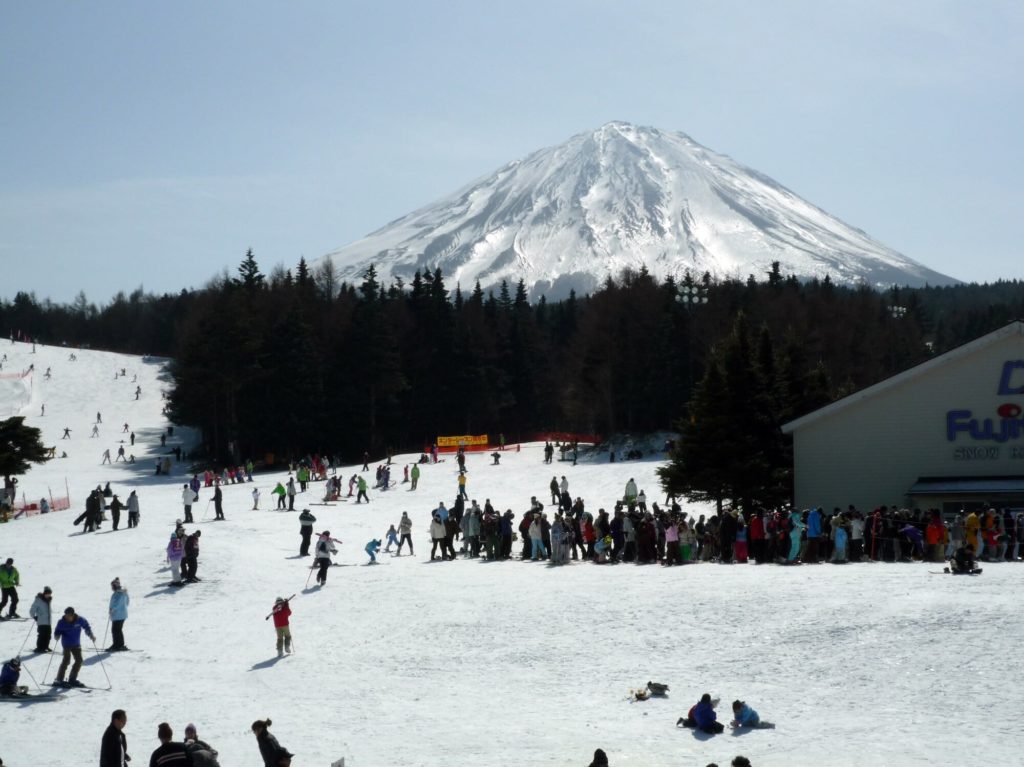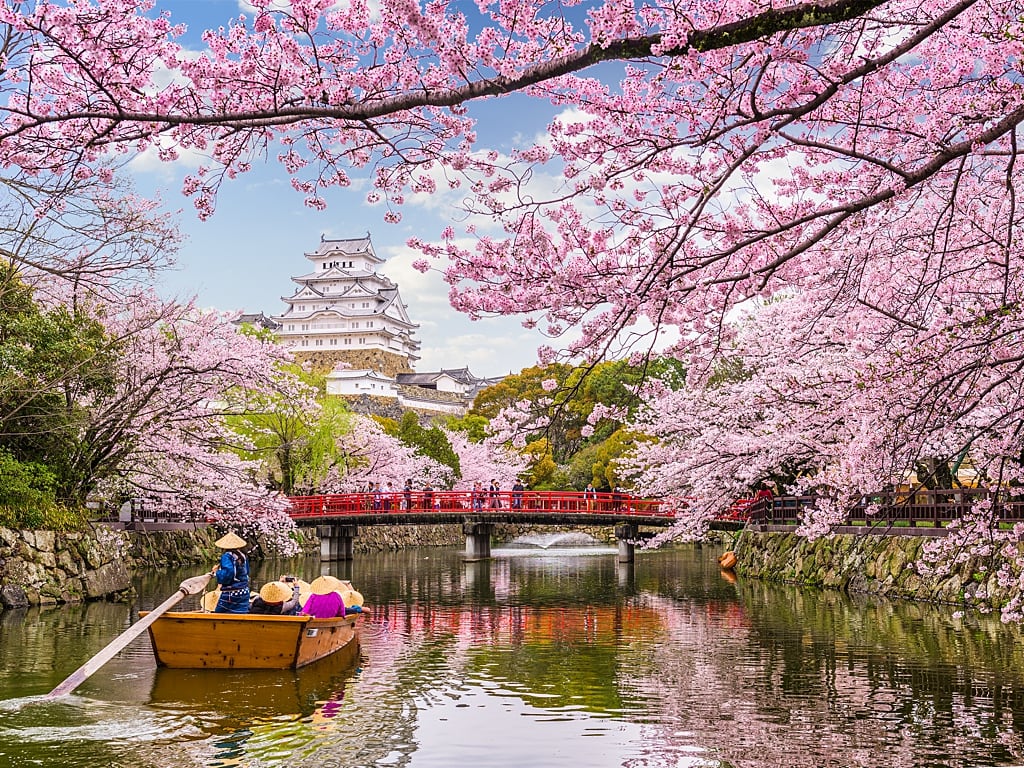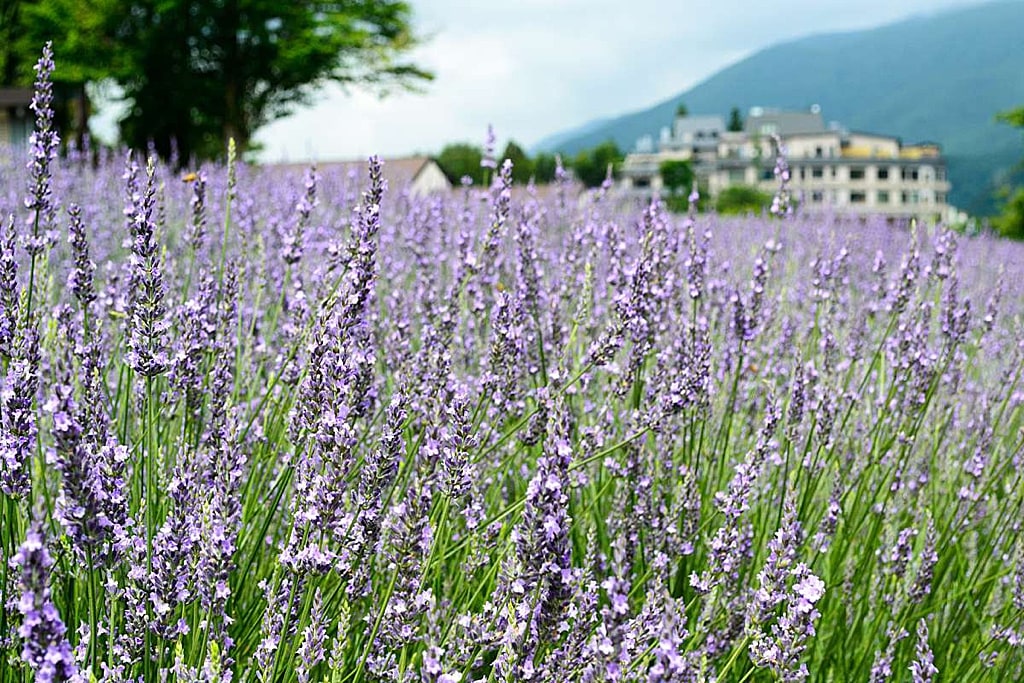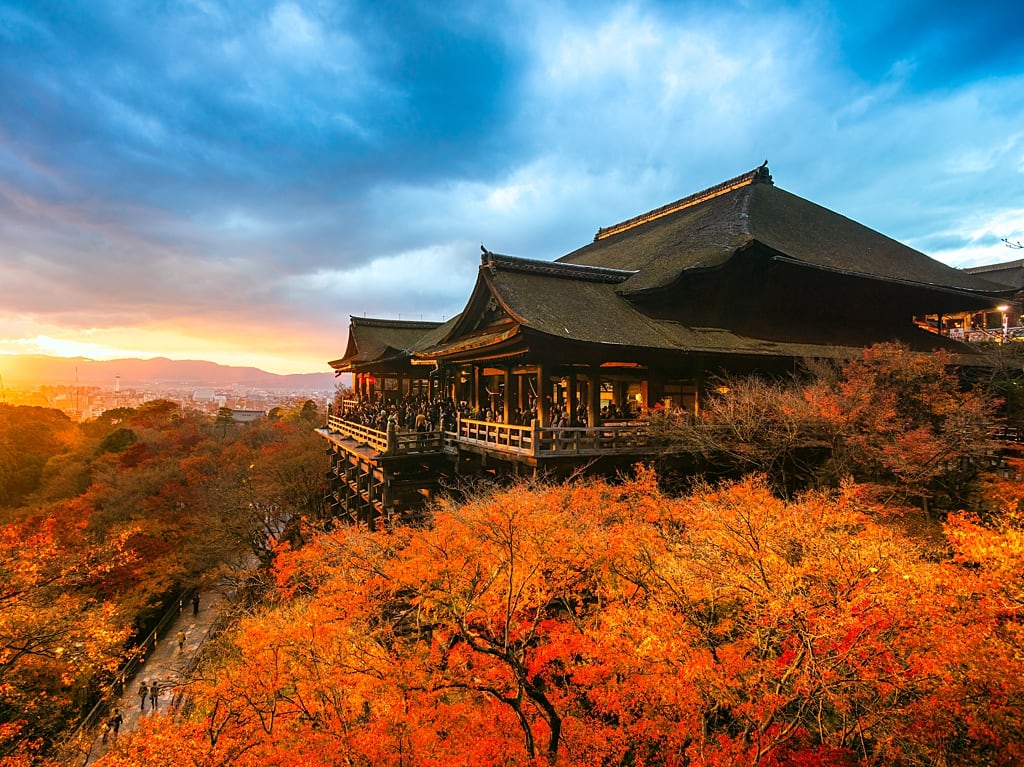When Is the Worst Time to Go to Travel
Japan has considerately no all-time time to visit as each season offers a different experience and spectacular beauty. Jump and autumn are exceptional when planning a trip to Japan, where the land has the most heady cultural festivals and temperate weather. Simply there's more to Nippon than red blossoms and autumn leaf colour. Allow'southward take a closer look.
What is the climate like in Japan?
You would likely make Tokyo the focal point of your trip, so permit's try to understand the city's climate a little better. Tokyo lies on the eastern shore of Japan's largest master island chosen Honshu, with a temperate seasonal wind zone closely resembling the East Coast of the U.S. The main difference is that Tokyo doesn't get much snow in winter and experiences an unbearable "urban heat island" effect similar to Florida and Washington, DC, in summertime. In a higher place all, expect to rain at any time of the year when traveling in Nippon, except in Hokkaido's northernmost part. Nosotros recommend visiting the Japan Meteorological Agency website at https://www.jma.go.jp/en/yoho/ for detailed daily weather condition forecasts.
Hither are some guidelines to keep in listen when visiting Nippon:
- Winter (December, January, February) is marked by snowfall in many areas, specially in the regions shut to the Japanese Alps. Southern Japan, yet, enjoys a warm and mostly mild climate. The northern part of Japan has a boiling continental climate, where they savour cool summers but feel windy and heavy snow.
- Bound (March, April, May) is famous for cherry blossoms blooming throughout Japan and the year'southward most popular fourth dimension. Look large crowds and peak season pricing. The monsoon season, even so, starts in May.
- Summer (June, July, Baronial) is famous for hikers looking to conquer Mt. Fuji's summit.
- Fall (September, Oct, November) is among the best times to visit Japan, specially in more rural Chubu and Tohoku areas.
What are the best months to visit Nippon?
- Mid-March to early on May and mid-Oct to early on December are the best months to visit Nihon due to its stunning colors and mild weather condition.
- If you enjoy the snow, low crowds, and value flavor pricing, January to Feb are the best months to visit.
What are the worst times to visit Japan?
- Golden Calendar week can be the worst time to visit Nippon. It is the most famous holiday in Japan, which takes place from the end of Apr and through May's first calendar week. About a total calendar week where almost every business organization in Nihon shuts downwardly and domestic travel skyrockets, which adds endless traffic jams and crowds.
Winter in Nihon

- Wintertime in Nihon lasts from Dec to February.
- Boilerplate temperature ranges from ii-xi ℃ (36-52 ℉).
Our second favorite time of year due to low crowds and traveling in Japan is cheap. The weather may sound unpleasant to most, but one tin can hands manage information technology with the right wearing apparel and grooming. Larger cities have more often than not clear skies and offering magnificent views of the snow-capped Fuji from equally far abroad as Tokyo and Yokohama. If you lot find yourself visiting in February, you lot tin can catch the plum blossom flavor and experienceume matsuri (plum festivals) in Tokyo's suburbs.
Wintertime as well brings magical, sparkling white blankets to Nippon'south mountainous areas, so make sure to visit the popular winter illumination result in Shirakawa-Go for a winter wonderland and Hallmark Christmas feel. Hokkaido in northern Japan takes the block in winter festivities, however. Their annual Water ice Festival in Sapporo offers some of the virtually incredible ice sculptures you'll ever come across and enough of opportunities to indulge in local cuisine like the Hokkaido ramen.
The famous Japanese macaques (snow monkeys) in Jigokudani Monkey Park is another full winter experience. They are the only wild monkeys in the world known to breast-stroke in natural geothermal hot springs. Just merely observing them is a unique experience.
Winter in Nihon also means visiting museums, slurping ramens, enjoying sake, and soaking in an onsen (hot spring) if you want to stay indoors. On the other hand, Okinawa has a unlike nature with a subtropical climate where they enjoy mild winters, hovering comfortably from 15-20 ℃ (59-68 ℉) in January and Feb.
Tips When Visiting Japan in Winter
- The air in Japan in wintertime is arid, oft beneath 40% humidity level. We'd recommend that yous stay in hotels rather than cheap Airbnbs. Hotels in Japan provide humidifiers in each room to prevent dry and sore throat while sleeping.
- Spend some time exploring the manyonsen (hot spring) towns surrounding Nippon'due south many mountains. Relaxing in an outdoor onsen tin exist a surreal feel, not soon forgotten.
- While Nagano might be the nigh famous, there are enough of destinations to ski and snowboard, such every bit Niseko Winter Resort and Furano Wintertime Resort, so consider them as well.
- Unless y'all're explicitly required to travel so, avoid visiting during New year as the prices for flights and accommodations skyrocket during that time.
Spring in Nippon

- Spring weather condition in Japan lasts from mid-March to May.
- The average temperature ranges from 9-20 ℃ (48-68 ℉), mostly warm and cold, but not hot or extreme cold. Nevertheless, in early March, yous will still feel freezing, especially in the forenoon.
Thanks to ruby blossoms, botanical wonders, numerous festivities, and mild weather, spring is the nigh popular time to visit Japan, and tourists will overrun every popular tourist attraction. Accommodations will book upwardly months in accelerate, leaving few vacancies and top season rates due to need.
The blood-red blossoms in Japan usually flower around the terminate of March until early on Apr. These are the loveliest days in larger cities like Tokyo, Yokohama, Osaka, and Kyoto forhanami (cherry blossom viewing). The entire blooming period can concluding for 10-xiv days. But frequent rains tin knock the petals off pretty quickly.
Should you miss the cherry blossoms, you tin can still feel plenty of spring promises in Japan. Scout a spring G Sumo tournament in May, traverse the Japanese alpine routes, or visit other floral hotspots throughout Nippon. The wisteria tunnel of Kawachi Fujien Garden in Fukuoka, Nemophila blossoms of Hitachi Seaside Park in Ibaraki, andshibazakura (pinkish moss) in Motosuko most Mt. Fuji are merely one of the best places to experience the botanical wonders of Nippon.
Tips When Visiting Japan in Spring
- Prepare and book everything in accelerate, ideally half dozen-12 months before traveling.
- Pack your weatherproof coat for unexpected showers.
- Japan has an incredible amount of pollen fromsugi (Japanese cedar) and Japanese cypress copse. Bring some allergy medications even if you lot don't unremarkably suffer from allergies, especially if you travel from mid-March until mid-April, the peak pollen flavour.
- Attempt and notice a smaller park with cherry blossoms if possible. Tourists will pack the significant city parks in Tokyo, Kyoto, and Osaka.
Summertime in Japan

- Summertime in Nihon lasts from June to Baronial.
- The average temperature ranges from 18-30 ℃ (64-85 ℉).
Still, it often feels much hotter due to the humidity with weeks of rain, which eventually gives fashion to steamy and often unbearably humid summers. The Japanese have a term for it: mushi atsui which literally translates to "steam and hot."
Summer too means enjoying vibrant matsuri (festivals), barbeques, ice-cold beer, camping, and witnessing dazzling fireworks. The annualObon Festival is ane of the biggest and most important festivals in Japan. If you're lucky, yous may even become a chance to participate in them as well! For the adventure rush, Nihon offers plenty of outdoor activities scattered throughout the state, from the all-time stretches of whitewater rafting in the town of Minakami to Okinawa's exquisite underwater seascape perfect for scuba diving.
Many climb Mt. Fuji from July until early September. But if you are non prepare to conquer its summit, there are plenty of things to do in the surrounding expanse, specially in Lake Kawaguchi. Fuji-Q Highland, Oshino Hakkai, Chureito Pagoda, and the Lake Kawaguchi Mt. Tenjo Ropeway are but some of the pinnacle places where yous can admire Mt. Fuji'due south majesty from below.
To escape the brutal heat, tailor your itinerary with a visit to the mount towns such as Matsumoto, Hida-Takayama, and Toyama. Or visit Hokkaido that is overjoyed by several national parks and sparkling, glittering lakes. These places accept much milder climates in summertime while still offering plenty of activities and festivals.
Tips When Visiting Japan in Summer
- Summer is a time foryatai (food stalls). Indulge your inner bon vivant! Comport greenbacks when you visit food stalls.
- Bring a modest towel for wiping away sweat.
- Typhoon season peaks in August, so keep a close eye on the atmospheric condition forecasts.
Autumn in Nihon

- Autumn in Japan lasts from September to November.
- The average temperature ranges from 9-26 ℃ (48-79 ℉).
The colorful maples and ginkgo leaves make fall the apparent alternative to Nippon's spring reddish blossoms, so it is the second near popular tourist season. Koyo (ruby leaves) in larger cities such as Tokyo, Yokohama, Kyoto, and Osaka start to change from mid-November to early on December. The clear skies and irresolute leaves make for some spectacular views from atop the many mountains, so hiking and landscape photography are prevalent this twelvemonth.
Cultural activities take heart-stage during this season besides. Make sure to include Japanese experiences such equally watching the autumn Sumo Grand Tournament, cooking classes, tea ceremonies, kimono experiences, and traditional craft. Many festivals throughout the state too happen in October. One of the near impressive festivals is the Takayama Autumn Festival that takes place every October 9-ten. German Christmas markets and wintertime illuminations in Sapporo, Tokyo, and Osaka starts in Nov.
Tips When Visiting Japan in Fall
- As with the spring, fall travel requires a bit of lead time when booking your trip. And then attempt to plan and reserve everything at least half-dozen months ahead of your flight.
- To avoid the large crowds of tourists (or 'leaf peers' every bit we phone call them in Maine), visit more rural areas of Chubu and Tohoku regions where their vast deciduous forests bandage aside their emerald hues for vivid reds, yellows, and oranges.
- To avert the elevation typhoon months, consider delaying your trip to Nov until early December. At that place are still plenty of places for fall leaf viewing if y'all can bargain with the slightly cooler temperatures.
Conclusion
Planning a trip to Nihon requires all-encompassing research and training. Deciding on the best time to visit ultimately comes down to your personal preference. Do yous want to see the crimson blossoms, climb Fuji, or take part in wintertime activities? So y'all'll need to travel during the corresponding season for each. Accept a wait at the activities and experiences you find well-nigh of import to your itinerary and plan around that.
Sightsee & Sushi is a participant in the Amazon Services LLC Assembly Program, an chapter advertising plan designed to provide a means for sites to earn advertising fees by advert and linking to Amazon.com
0 Response to "When Is the Worst Time to Go to Travel"
Post a Comment